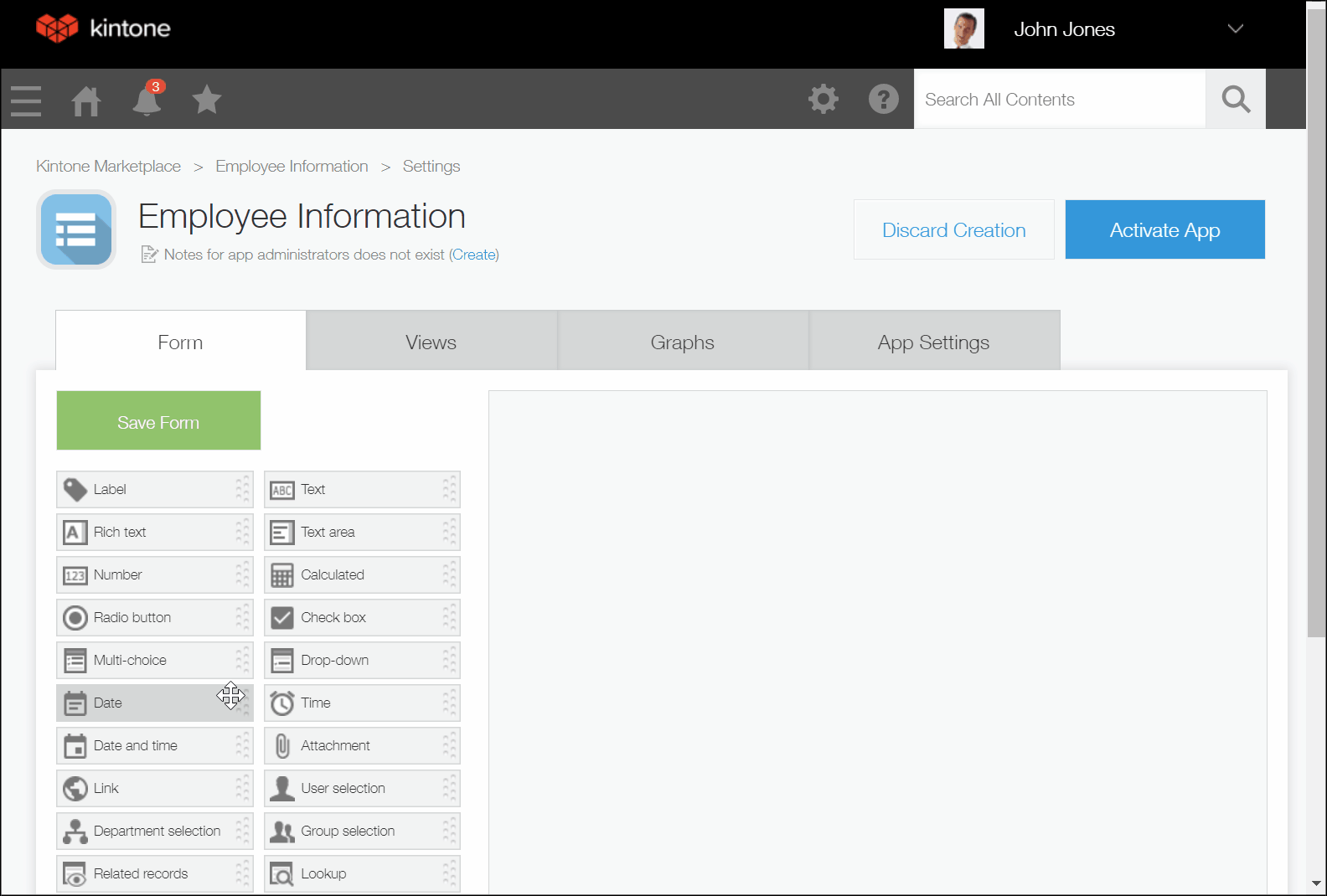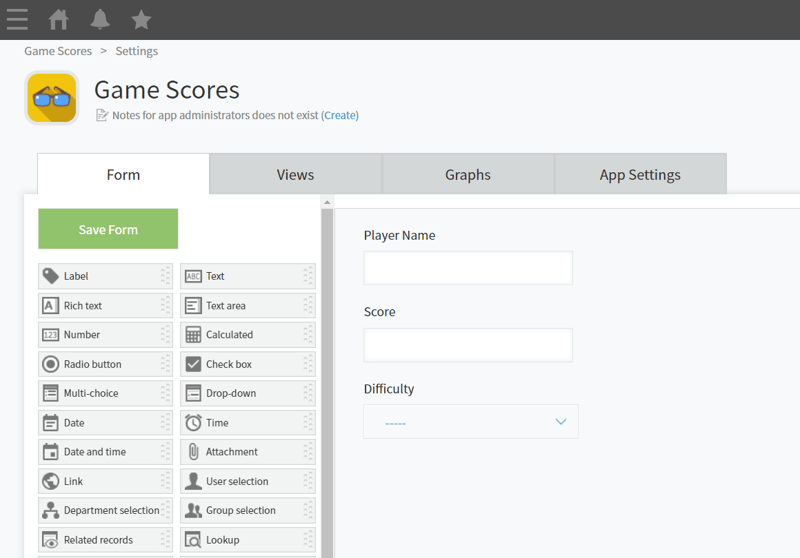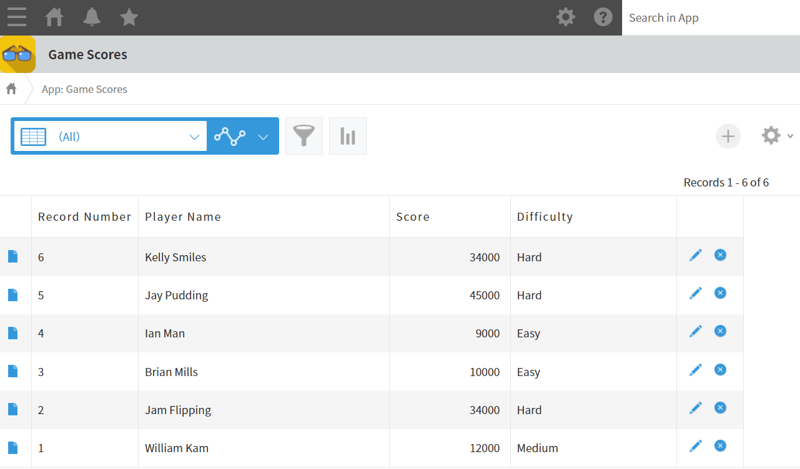在黑客馬拉松中使用 Kintone 的技巧
Introduction
When you're participating in a hackathon, efficiency and quick iteration are key to success. One tool that can help you manage data efficiently is Kintone, a powerful no-code/low-code platform that allows you to create web-based databases with ease.
In this guide, we'll walk you through how to create a simple Kintone App to store scores for games, and demonstrate how to interact with the Kintone API using some local Python code.
Get your Kintone Environment
First we need to get our hands on a Kintone Environment!
Developers are entitled to use the Kintone Developer License - an environment that can be used for free for 1 year ❤
Get your Kintone Developer License by filling out the form.
https://kintone.dev/en/developer-license-registration-form/
Create your Kintone Database
Web Databases in Kintone are called "Apps".
Creating these Apps are easy in Kintone - you can drag-and-drop the fields that you need, without needing to code.

Follow the instructions on the following link to create a new App.
https://get.kintone.help/k/en/id/040133.html
These are the fields we will include in the Kintone App for this article:
| Field Type | Field Name | Field Code |
|---|---|---|
| Text | Player Name | playername |
| Number | Score | score |
| Text | Difficulty | difficulty |
The field layout should look like the following:

After that, proceed to the Settings tab, and generate an API Token that will be used for the authentication. Set the permissions for View records and Add records.
https://get.kintone.help/k/en/id/040471.html
Once this is done, save the settings, and click on the blue "Activate App" button.
Manually Input Some Data
Since there is no data yet inside the App, manually add in some data so that we have something to work with.
https://get.kintone.help/k/en/id/040715.html

Now we're ready to interact with the Web Database with some Python code!
Sample Python Code to Interact with Kintone
Now that your app is set up, let's look at how you can interact with the Kintone API using Python. We'll cover how to add a record, retrieve all records, and query records based on difficulty.
Get a Python environment ready on your local machine. Since we will be using the requests library to make our API calls, install the library with the following command:
pip install requests
1. Adding a Record to the Kintone App
Below is a sample Python script that adds a new record to the Kintone App.
import requests
import json
def add_record():
API_endpoint = "https://{YOUR_SUBDOMAIN}.cybozu.com/k/v1/record.json"
app_id = "{APP_ID}"
kintone_headers = {
"X-Cybozu-API-Token": "{API_TOKEN}",
"Content-Type": "application/json"
}
bodydata = {
"app": app_id,
"record": {
"player": {
"value": "John Doe"
},
"score": {
"value": "1500"
},
"diff": {
"value": "Medium"
}
}
}
try:
response = requests.post(API_endpoint, headers=kintone_headers, data=json.dumps(bodydata))
jsondata = response.json()
print(jsondata)
except requests.exceptions.RequestException as error:
print(error)
add_record()
The App ID is a number that can be found in the URL of the Kintone App.
If the request is successful, a JSON is responded that includes the ID of the newly added record.
{'id': '7', 'revision': '1'}
If the request is successful, but the record data is empty, it may be because the keys inside the body data were incorrect. Make sure that the keys for the fields are stated as their field codes, and not their field names.
2. Retrieving All Records from the Kintone App
The following Python script will retrieve all records stored in your Kintone App.
import requests
def get_all_records():
API_endpoint = "https://{YOUR_SUBDOMAIN}.cybozu.com/k/v1/records.json"
app_id = "{APP_ID}"
API_endpoint = API_endpoint "?app=" app_id
kintone_headers = {
"X-Cybozu-API-Token": "{API_TOKEN}",
}
try:
response = requests.get(API_endpoint, headers=kintone_headers)
jsondata = response.json()
print(jsondata)
except requests.exceptions.RequestException as error:
print(error)
get_all_records()
If the request is successful, the response will include a JSON of all the records in the App.
"records": [
{
"difficulty": {
"type": "DROP_DOWN",
"value": null
},
"score": {
"type": "NUMBER",
"value": "1500"
},
"Record Number": {
"type": "RECORD_NUMBER",
"value": "7"
},
"Updated By": {
"type": "MODIFIER",
"value": {
"code": "Administrator",
"name": "Administrator"
}
},
"Created By": {
"type": "CREATOR",
"value": {
"code": "Administrator",
"name": "Administrator"
}
},
"playername": {
"type": "SINGLE_LINE_TEXT",
"value": ""
},
"$revision": {
"type": "__REVISION__",
"value": "1"
},
"Updated Datetime": {
"type": "UPDATED_TIME",
"value": "2024-10-06T02:33:00Z"
},
"Created Datetime": {
"type": "CREATED_TIME",
"value": "2024-10-06T02:33:00Z"
},
"$id": {
"type": "__ID__",
"value": "7"
}
},
{
"difficulty": {
"type": "DROP_DOWN",
"value": "Hard"
},
"score": {
"type": "NUMBER",
"value": "34000"
},
"Record Number": {
"type": "RECORD_NUMBER",
"value": "6"
},
"Updated By": {
"type": "MODIFIER",
"value": {
"code": "will",
"name": "will-yama"
}
},
"Created By": {
"type": "CREATOR",
"value": {
"code": "will",
"name": "will-yama"
}
},
"playername": {
"type": "SINGLE_LINE_TEXT",
"value": "Kelly Smiles"
},
"$revision": {
"type": "__REVISION__",
"value": "1"
},
"Updated Datetime": {
"type": "UPDATED_TIME",
"value": "2024-10-06T01:41:00Z"
},
"Created Datetime": {
"type": "CREATED_TIME",
"value": "2024-10-06T01:41:00Z"
},
"$id": {
"type": "__ID__",
"value": "6"
}
},...
We have cut off the above JSON response half way through for this article, as it is quite long.
3. Retrieving Records with Query Filtering
In some cases, you may want to retrieve records based on specific conditions, such as fetching records where the difficulty is set to "Hard". Add a query to the GET request to achieve this.
import requests
def get_all_records():
API_endpoint = "https://{YOUR_SUBDOMAIN}.cybozu.com/k/v1/records.json"
app_id = "{APP_ID}"
query = "difficulty in (\"Hard\")"
API_endpoint = API_endpoint "?app=" app_id "&query=" query
kintone_headers = {
"X-Cybozu-API-Token": "{API_TOKEN}",
}
try:
response = requests.get(API_endpoint, headers=kintone_headers)
jsondata = response.json()
print(jsondata)
except requests.exceptions.RequestException as error:
print(error)
get_all_records()
If the request is successful, the response will include a JSON of the filtered records.
"records": [
{
"difficulty": {
"type": "DROP_DOWN",
"value": "Hard"
},
"score": {
"type": "NUMBER",
"value": "34000"
},
"Record Number": {
"type": "RECORD_NUMBER",
"value": "6"
},
"Updated By": {
"type": "MODIFIER",
"value": {
"code": "will",
"name": "William Sayama"
}
},
"Created By": {
"type": "CREATOR",
"value": {
"code": "will",
"name": "William Sayama"
}
},
"playername": {
"type": "SINGLE_LINE_TEXT",
"value": "Kelly Smiles"
},
"$revision": {
"type": "REVISION",
"value": "1"
},
"Updated Datetime": {
"type": "UPDATED_TIME",
"value": "2024-10-06T01:41:00Z"
},
"Created Datetime": {
"type": "CREATED_TIME",
"value": "2024-10-06T01:41:00Z"
},
"$id": {
"type": "ID",
"value": "6"
}
},
{
"difficulty": {
"type": "DROP_DOWN",
"value": "Hard"
},
"score": {
"type": "NUMBER",
"value": "45000"
},
"Record Number": {
"type": "RECORD_NUMBER",
"value": "5"
},
"Updated By": {
"type": "MODIFIER",
"value": {
"code": "will",
"name": "William Sayama"
}
},
"Created By": {
"type": "CREATOR",
"value": {
"code": "will",
"name": "William Sayama"
}
},
"playername": {
"type": "SINGLE_LINE_TEXT",
"value": "Jay Pudding"
},
"$revision": {
"type": "REVISION",
"value": "1"
},
"Updated Datetime": {
"type": "UPDATED_TIME",
"value": "2024-10-06T01:38:00Z"
},
"Created Datetime": {
"type": "CREATED_TIME",
"value": "2024-10-06T01:38:00Z"
},
"$id": {
"type": "ID",
"value": "5"
}
},
{
"difficulty": {
"type": "DROP_DOWN",
"value": "Hard"
},
"score": {
"type": "NUMBER",
"value": "34000"
},
"Record Number": {
"type": "RECORD_NUMBER",
"value": "2"
},
"Updated By": {
"type": "MODIFIER",
"value": {
"code": "will",
"name": "William Sayama"
}
},
"Created By": {
"type": "CREATOR",
"value": {
"code": "will",
"name": "William Sayama"
}
},
"playername": {
"type": "SINGLE_LINE_TEXT",
"value": "Jam Flipping"
},
"$revision": {
"type": "REVISION",
"value": "2"
},
"Updated Datetime": {
"type": "UPDATED_TIME",
"value": "2024-10-06T01:38:00Z"
},
"Created Datetime": {
"type": "CREATED_TIME",
"value": "2024-10-05T01:26:00Z"
},
"$id": {
"type": "ID",
"value": "2"
}
}
],
"totalCount": null
Conclusion
By setting up a Kintone App and interacting with it via API, you can easily manage data for your projects. Whether you're keeping track of player performances or storing other types of data, Kintone’s flexible API makes it easy to integrate into any hackathon project.
This guide has provided examples for adding records, retrieving all records, and querying records with specific conditions, allowing you to customize your data management according to your needs.
Good luck at your hackathon, and happy coding with Kintone!
-
 如何實時捕獲和流媒體以進行聊天機器人命令執行?在開發能夠執行命令的chatbots的領域中,實時從命令執行實時捕獲Stdout,一個常見的需求是能夠檢索和顯示標準輸出(stdout)在cath cath cant cant cant cant cant cant cant cant interfaces in Chate cant inter...程式設計 發佈於2025-05-15
如何實時捕獲和流媒體以進行聊天機器人命令執行?在開發能夠執行命令的chatbots的領域中,實時從命令執行實時捕獲Stdout,一個常見的需求是能夠檢索和顯示標準輸出(stdout)在cath cath cant cant cant cant cant cant cant cant interfaces in Chate cant inter...程式設計 發佈於2025-05-15 -
 Java數組中元素位置查找技巧在Java數組中檢索元素的位置 利用Java的反射API將數組轉換為列表中,允許您使用indexof方法。 (primitives)(鏈接到Mishax的解決方案) 用於排序陣列的數組此方法此方法返回元素的索引,如果發現了元素的索引,或一個負值,指示應放置元素的插入點。程式設計 發佈於2025-05-15
Java數組中元素位置查找技巧在Java數組中檢索元素的位置 利用Java的反射API將數組轉換為列表中,允許您使用indexof方法。 (primitives)(鏈接到Mishax的解決方案) 用於排序陣列的數組此方法此方法返回元素的索引,如果發現了元素的索引,或一個負值,指示應放置元素的插入點。程式設計 發佈於2025-05-15 -
 如何使用Regex在PHP中有效地提取括號內的文本php:在括號內提取文本在處理括號內的文本時,找到最有效的解決方案是必不可少的。一種方法是利用PHP的字符串操作函數,如下所示: 作為替代 $ text ='忽略除此之外的一切(text)'; preg_match('#((。 &&& [Regex使用模式來搜索特...程式設計 發佈於2025-05-15
如何使用Regex在PHP中有效地提取括號內的文本php:在括號內提取文本在處理括號內的文本時,找到最有效的解決方案是必不可少的。一種方法是利用PHP的字符串操作函數,如下所示: 作為替代 $ text ='忽略除此之外的一切(text)'; preg_match('#((。 &&& [Regex使用模式來搜索特...程式設計 發佈於2025-05-15 -
 PHP陣列鍵值異常:了解07和08的好奇情況PHP數組鍵值問題,使用07&08 在給定數月的數組中,鍵值07和08呈現令人困惑的行為時,就會出現一個不尋常的問題。運行print_r($月份)返回意外結果:鍵“ 07”丟失,而鍵“ 08”分配給了9月的值。 此問題源於PHP對領先零的解釋。當一個數字帶有0(例如07或08)的前綴時,PHP...程式設計 發佈於2025-05-15
PHP陣列鍵值異常:了解07和08的好奇情況PHP數組鍵值問題,使用07&08 在給定數月的數組中,鍵值07和08呈現令人困惑的行為時,就會出現一個不尋常的問題。運行print_r($月份)返回意外結果:鍵“ 07”丟失,而鍵“ 08”分配給了9月的值。 此問題源於PHP對領先零的解釋。當一個數字帶有0(例如07或08)的前綴時,PHP...程式設計 發佈於2025-05-15 -
 如何使用PHP將斑點(圖像)正確插入MySQL?essue VALUES('$this->image_id','file_get_contents($tmp_image)')";This code builds a string in PHP, but the function call fil...程式設計 發佈於2025-05-15
如何使用PHP將斑點(圖像)正確插入MySQL?essue VALUES('$this->image_id','file_get_contents($tmp_image)')";This code builds a string in PHP, but the function call fil...程式設計 發佈於2025-05-15 -
 Python中嵌套函數與閉包的區別是什麼嵌套函數與python 在python中的嵌套函數不被考慮閉合,因為它們不符合以下要求:不訪問局部範圍scliables to incling scliables在封裝範圍外執行範圍的局部範圍。 make_printer(msg): DEF打印機(): 打印(味精) ...程式設計 發佈於2025-05-15
Python中嵌套函數與閉包的區別是什麼嵌套函數與python 在python中的嵌套函數不被考慮閉合,因為它們不符合以下要求:不訪問局部範圍scliables to incling scliables在封裝範圍外執行範圍的局部範圍。 make_printer(msg): DEF打印機(): 打印(味精) ...程式設計 發佈於2025-05-15 -
 C++成員函數指針正確傳遞方法如何將成員函數置於c [&& && && && && && && && && && &&&&&&&&&&&&&&&&&&&&&&&華儀的函數時,在接受成員函數指針的函數時,要在函數上既要提供指針又可以提供指針和指針到函數的函數。需要具有一定簽名的功能指針。要通過成員函數,您需要同時提供對象指針(此...程式設計 發佈於2025-05-15
C++成員函數指針正確傳遞方法如何將成員函數置於c [&& && && && && && && && && && &&&&&&&&&&&&&&&&&&&&&&&華儀的函數時,在接受成員函數指針的函數時,要在函數上既要提供指針又可以提供指針和指針到函數的函數。需要具有一定簽名的功能指針。要通過成員函數,您需要同時提供對象指針(此...程式設計 發佈於2025-05-15 -
 在Python中如何創建動態變量?在Python 中,動態創建變量的功能可以是一種強大的工具,尤其是在使用複雜的數據結構或算法時,Dynamic Variable Creation的動態變量創建。 Python提供了幾種創造性的方法來實現這一目標。 利用dictionaries 一種有效的方法是利用字典。字典允許您動態創建密鑰並...程式設計 發佈於2025-05-15
在Python中如何創建動態變量?在Python 中,動態創建變量的功能可以是一種強大的工具,尤其是在使用複雜的數據結構或算法時,Dynamic Variable Creation的動態變量創建。 Python提供了幾種創造性的方法來實現這一目標。 利用dictionaries 一種有效的方法是利用字典。字典允許您動態創建密鑰並...程式設計 發佈於2025-05-15 -
 Android如何向PHP服務器發送POST數據?在android apache httpclient(已棄用) httpclient httpclient = new defaulthttpclient(); httppost httppost = new httppost(“ http://www.yoursite.com/script.p...程式設計 發佈於2025-05-15
Android如何向PHP服務器發送POST數據?在android apache httpclient(已棄用) httpclient httpclient = new defaulthttpclient(); httppost httppost = new httppost(“ http://www.yoursite.com/script.p...程式設計 發佈於2025-05-15 -
 如何在Java的全屏獨家模式下處理用戶輸入?Handling User Input in Full Screen Exclusive Mode in JavaIntroductionWhen running a Java application in full screen exclusive mode, the usual event ha...程式設計 發佈於2025-05-15
如何在Java的全屏獨家模式下處理用戶輸入?Handling User Input in Full Screen Exclusive Mode in JavaIntroductionWhen running a Java application in full screen exclusive mode, the usual event ha...程式設計 發佈於2025-05-15 -
 `console.log`顯示修改後對象值異常的原因foo = [{id:1},{id:2},{id:3},{id:4},{id:id:5},],]; console.log('foo1',foo,foo.length); foo.splice(2,1); console.log('foo2', foo, foo....程式設計 發佈於2025-05-15
`console.log`顯示修改後對象值異常的原因foo = [{id:1},{id:2},{id:3},{id:4},{id:id:5},],]; console.log('foo1',foo,foo.length); foo.splice(2,1); console.log('foo2', foo, foo....程式設計 發佈於2025-05-15 -
 您如何在Laravel Blade模板中定義變量?在Laravel Blade模板中使用Elegance 在blade模板中如何分配變量對於存儲以後使用的數據至關重要。在使用“ {{}}”分配變量的同時,它可能並不總是最優雅的解決方案。 幸運的是,Blade通過@php Directive提供了更優雅的方法: $ old_section =...程式設計 發佈於2025-05-15
您如何在Laravel Blade模板中定義變量?在Laravel Blade模板中使用Elegance 在blade模板中如何分配變量對於存儲以後使用的數據至關重要。在使用“ {{}}”分配變量的同時,它可能並不總是最優雅的解決方案。 幸運的是,Blade通過@php Directive提供了更優雅的方法: $ old_section =...程式設計 發佈於2025-05-15 -
 如何使用不同數量列的聯合數據庫表?合併列數不同的表 當嘗試合併列數不同的數據庫表時,可能會遇到挑戰。一種直接的方法是在列數較少的表中,為缺失的列追加空值。 例如,考慮兩個表,表 A 和表 B,其中表 A 的列數多於表 B。為了合併這些表,同時處理表 B 中缺失的列,請按照以下步驟操作: 確定表 B 中缺失的列,並將它們添加到表的...程式設計 發佈於2025-05-15
如何使用不同數量列的聯合數據庫表?合併列數不同的表 當嘗試合併列數不同的數據庫表時,可能會遇到挑戰。一種直接的方法是在列數較少的表中,為缺失的列追加空值。 例如,考慮兩個表,表 A 和表 B,其中表 A 的列數多於表 B。為了合併這些表,同時處理表 B 中缺失的列,請按照以下步驟操作: 確定表 B 中缺失的列,並將它們添加到表的...程式設計 發佈於2025-05-15 -
 Python高效去除文本中HTML標籤方法在Python中剝離HTML標籤,以獲取原始的文本表示Achieving Text-Only Extraction with Python's MLStripperTo streamline the stripping process, the Python standard librar...程式設計 發佈於2025-05-15
Python高效去除文本中HTML標籤方法在Python中剝離HTML標籤,以獲取原始的文本表示Achieving Text-Only Extraction with Python's MLStripperTo streamline the stripping process, the Python standard librar...程式設計 發佈於2025-05-15 -
 eval()vs. ast.literal_eval():對於用戶輸入,哪個Python函數更安全?稱量()和ast.literal_eval()中的Python Security 在使用用戶輸入時,必須優先確保安全性。強大的python功能eval()通常是作為潛在解決方案而出現的,但擔心其潛在風險。 This article delves into the differences betwee...程式設計 發佈於2025-05-15
eval()vs. ast.literal_eval():對於用戶輸入,哪個Python函數更安全?稱量()和ast.literal_eval()中的Python Security 在使用用戶輸入時,必須優先確保安全性。強大的python功能eval()通常是作為潛在解決方案而出現的,但擔心其潛在風險。 This article delves into the differences betwee...程式設計 發佈於2025-05-15
學習中文
- 1 走路用中文怎麼說? 走路中文發音,走路中文學習
- 2 坐飛機用中文怎麼說? 坐飞机中文發音,坐飞机中文學習
- 3 坐火車用中文怎麼說? 坐火车中文發音,坐火车中文學習
- 4 坐車用中文怎麼說? 坐车中文發音,坐车中文學習
- 5 開車用中文怎麼說? 开车中文發音,开车中文學習
- 6 游泳用中文怎麼說? 游泳中文發音,游泳中文學習
- 7 騎自行車用中文怎麼說? 骑自行车中文發音,骑自行车中文學習
- 8 你好用中文怎麼說? 你好中文發音,你好中文學習
- 9 謝謝用中文怎麼說? 谢谢中文發音,谢谢中文學習
- 10 How to say goodbye in Chinese? 再见Chinese pronunciation, 再见Chinese learning

























